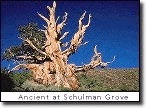|
|
Here are a few links to Mammoth websites and favorite poetry.
-
This book has more than
300 pages of highly informative text covering problems faced by caregivers.
-
Cutting
through spiritual and political confusion since 1976
by
Woolly Charles Buckman Ellis.
The stand is this: the time between now and my
death has already been counted, the days a known quantity,
though concealed. The space between home and the cities
requires care in the use of travel, travel I choose to devote
mainly to art and friends. Therefore, I will, even more than I
have in the past, frame my work projects as matters for the
student, the scholar and devote time to them in the measured and
consistent way I know well. At some point I will turn that work
over to the poet for creation of manuscripts: essays, poems,
books. The monk's role will be to keep my spirit steady and
refreshed, in contact always with the geist as it interacts with
my Self. In the overall I place family first and the scholar's
labor second, the monk's rhythm will define my days, and the
poet's sensibility my creations.
-
Poems
by Rumi
-
Mammoth Site,
Hot Springs, S.D.
-
Woolly
Mammoth  Woolly
Mammoths (scientific name Mammuthus primigenius) are extinct herbivorous
mammals that had long, dense, dark black hair and underfur, long, curved
tusks, a fatty hump, a long proboscis (nose), and large ears. They lived
in the tundras of Asia, Europe, and North America. They lived from the
Pleistocene to the early Holocene epoch (about 10,000 years ago), millions
of years after the dinosaurs went extinct. They are closely related to
modern-day Indian elephants. They were about 11.5 feet (3.5 m) long, 9.5
feet (2.9 m) tall at the shoulder and weighed about 3 tons (2.75 tonnes).
The tusks were used for protection, in interspecies dominance, and for
digging in the snow of the ice ages for grass and other food. Much of our
knowledge of mammoths is from cave drawings found in France and Spain and
from mummified mammoths found in Siberian ice! (Classification: Family
Elephantidae)
Woolly
Mammoths (scientific name Mammuthus primigenius) are extinct herbivorous
mammals that had long, dense, dark black hair and underfur, long, curved
tusks, a fatty hump, a long proboscis (nose), and large ears. They lived
in the tundras of Asia, Europe, and North America. They lived from the
Pleistocene to the early Holocene epoch (about 10,000 years ago), millions
of years after the dinosaurs went extinct. They are closely related to
modern-day Indian elephants. They were about 11.5 feet (3.5 m) long, 9.5
feet (2.9 m) tall at the shoulder and weighed about 3 tons (2.75 tonnes).
The tusks were used for protection, in interspecies dominance, and for
digging in the snow of the ice ages for grass and other food. Much of our
knowledge of mammoths is from cave drawings found in France and Spain and
from mummified mammoths found in Siberian ice! (Classification: Family
Elephantidae)
-
Great
Woolly Mammoth Jokes
Imagine
a place unchanged since the end of the Great Ice Age. A place where the
mighty Woolly Mammoth might still roam!
-
The
Dwelling In The Woods was designed to provide a year round Hermitage
experience. As a guest at The
Dwelling you had the opportunity to live alone in a simple private
Hermitage omfortably surrounded by other Hermitages in the woods
or meadows. It is now the
Shire in
the Woods.
-
Blue Cloud Abbey, a Benedictine Monastery,
was founded in 1950 by St. Meinrad Archabbey in Indiana. The peaceful and beautiful rural
surroundings of NE South Dakota are conducive to a monastic life of prayer.
The first monks moved to Marvin, SD in the early 1950's and lived in
a small farm house on newly acquired land. Over the years, the monks
themselves constructed what is now
Abbey of the Hills retreat location.
-
Woolly
Mammoths: Evidence of Catastrophe?
Preservation of the mammoth remains was somewhat
different than has been imagined by the uninformed. The mammoths were
'mummified', a process that is quite easily done in a cold environment.
-
 The Ancient Bristlecone Pine
Earth's oldest living
inhabitant "Methuselah" at 4,767 years, has lived more than a millennium
longer than any other tree. Discover how these trees were found and where they
live. Learn of their unique strategies for survival. You can buy seeds
for this species at
TreeHelp.com
The Ancient Bristlecone Pine
Earth's oldest living
inhabitant "Methuselah" at 4,767 years, has lived more than a millennium
longer than any other tree. Discover how these trees were found and where they
live. Learn of their unique strategies for survival. You can buy seeds
for this species at
TreeHelp.com
.
Email
any feedback to
impactus@earthlink.net
This page was last updated on
12/28/20.
|